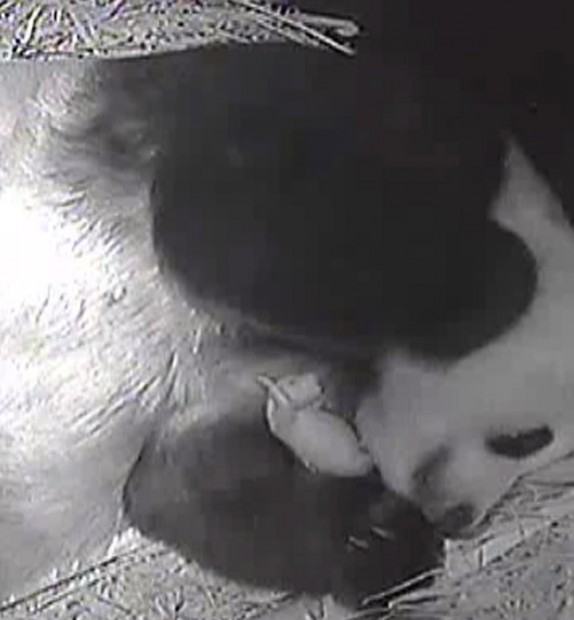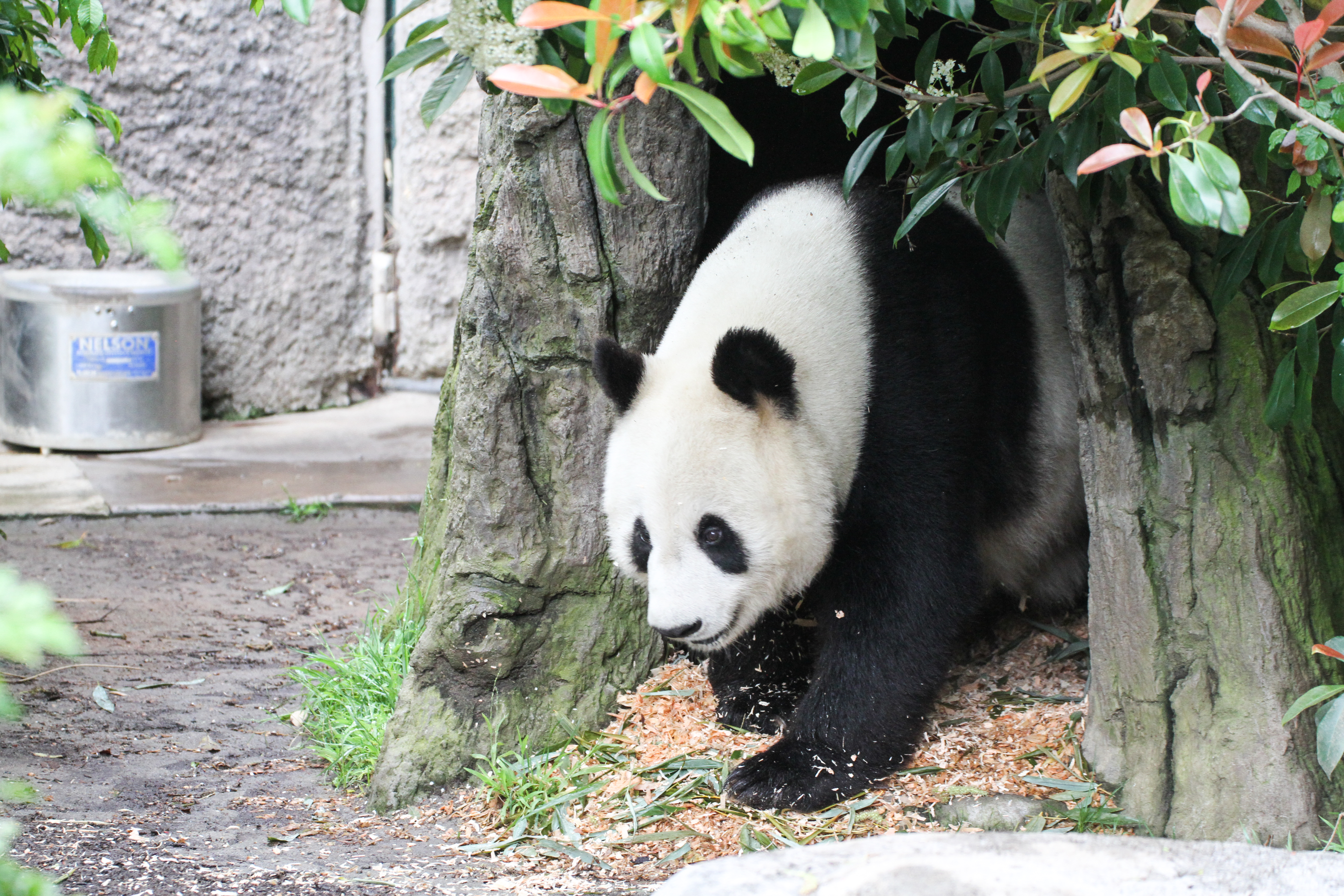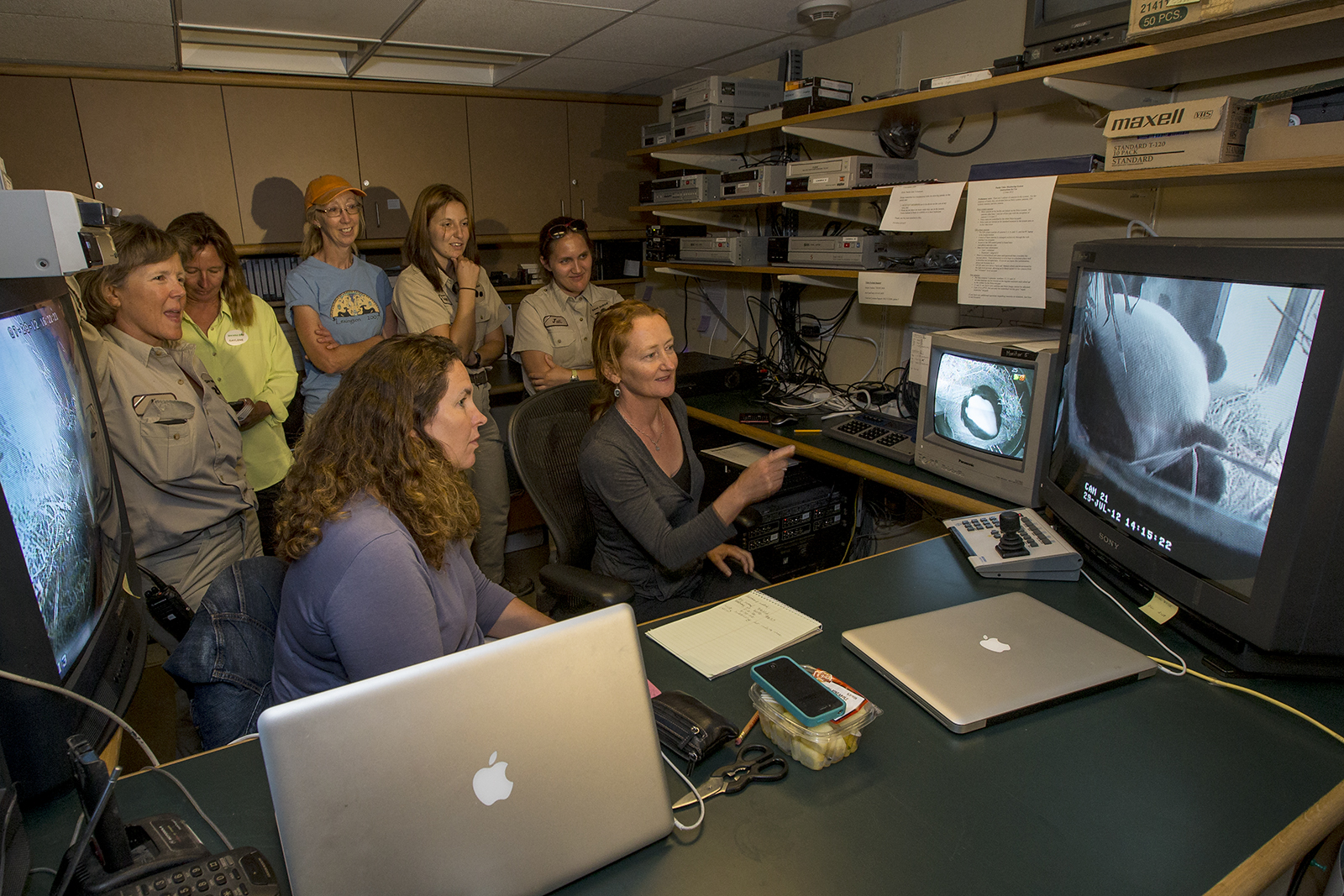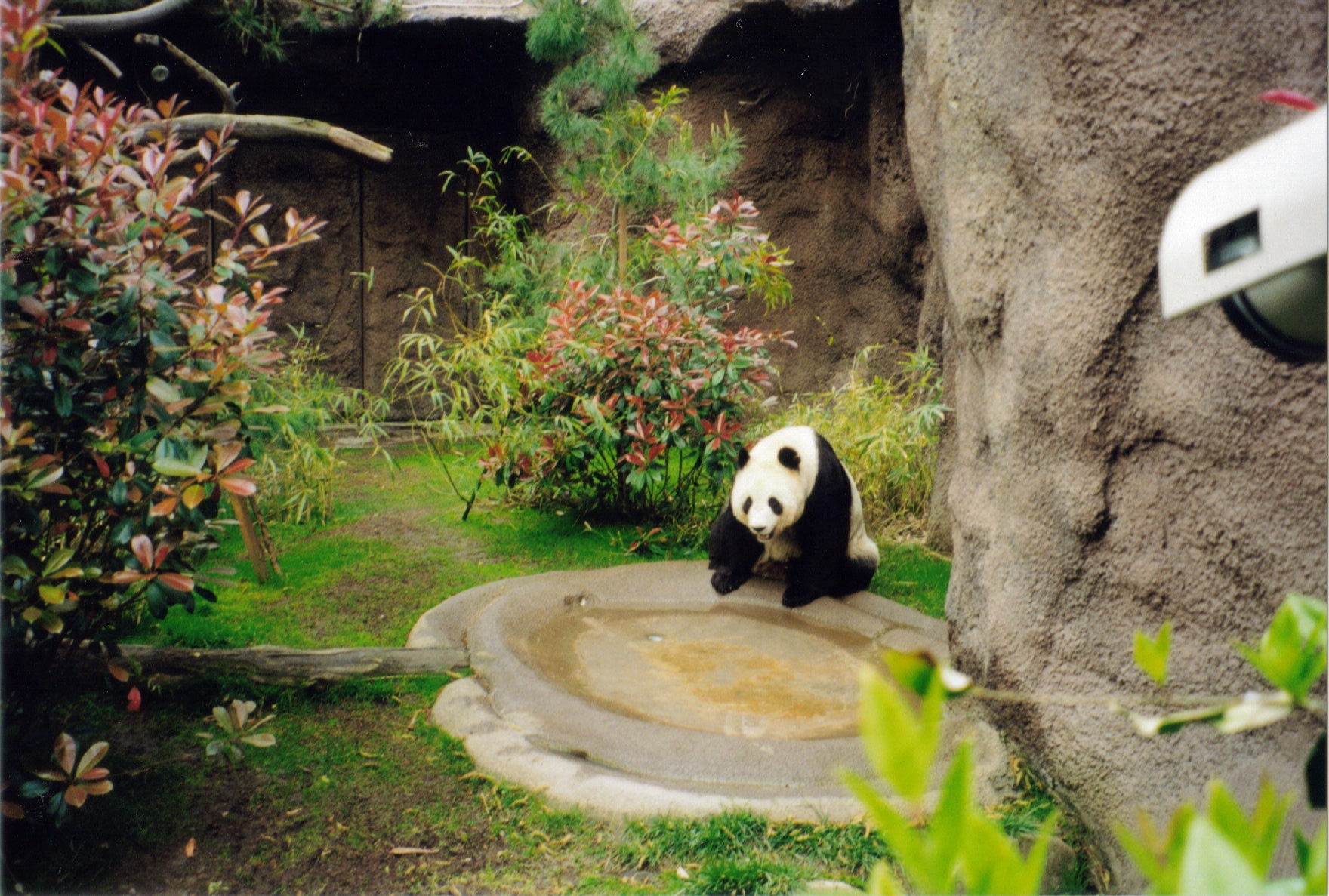San Diego Zoo Panda Cub Updates
San Diego Zoo posted many updates on their new panda cub:
August 15, 2012: You asked, we answer by Suzanne Hall:
As Bai Yun and her cub continue to do well, staff at the San Diego Zoo’s Giant Panda Research Station have slowly begun to emerge from the constant efforts of watching over the den activities to return to tasks put aside during the crucial early postpartum period. I’ve been reading through some of your comments and questions and thought I could offer some feedback.Regarding the repeated questions regarding Bai Yun’s age, her health, and her behavior with this cub: Bai Yun is doing just fine! She has been resting a lot, which is entirely normal at this stage postpartum. If this is your first panda cub, I encourage you to read through our blog archives and see that sluggishness on the part of momma bear is de rigueur at this stage. Pandas are bears, after all, and many bears experience months of fasting and rest coupled with the birth and early postpartum rearing of their young.
There have been some really good scientific papers written on the magnificent ability of female bears to lactate and care for their young without eating for long periods, noting that very little muscle wastage is evident despite these energetically costly events. Please don’t worry about Bai Yun. She is built for this, and she is taking good care of herself as well as of her cub. We are very pleased with their progress so far.
As an aside: you can see the activities in the den well, but you can’t see what Bai Yun is doing when she leaves the den. She has been getting regular drinks since day 1 postpartum. She has even been observed feeding on occasion. Although she isn’t consuming much yet, she has spent a little time feeding on bamboo and even snacked on biscuits. Her appetite will come back much faster than those cold-weather hibernators, but it is a gradual process. She is making expected changes to her intake every few days.
A few of you noted that the camera has been showing fewer close ups lately. We’ve started to add our other responsibilities into our day, and so when we do leave the monitoring room, we zoom out so the whole den is visible. I’ve noted that some of you are quick to record snippets of video when there is a nice, tight zoom on the cub. Keep sharing your videos with each other so that everyone can benefit from those close ups!
As to the heat in the area: yes, it’s been blazingly hot and humid in San Diego in the last week. But, as our moderator indicated, there is air conditioning in the bedroom area that opens to the den. This air is set to a constant temperature and can filter into the den. Even so, it can get hot in those mountains of China in the summertime; I recall a very sweaty walk up to George Schaller’s former research base in Wolong one summer afternoon. It was baking. The upshot is that these bears can handle a little heat, and Bai Yun has been very comfortable.
We still haven’t had the opportunity to take the new cub out of the den for its first exam. Bai Yun has been leaving the den, though not yet for the long periods we need to see before cub exams begin. That could change at any moment, based upon her needs, so stay tuned! Until that first cub exam, we won’t have a way to determine the gender of this youngster.
August 10, 2012: ‘True Colors’ by Megan Owen
At approximately 2:35 p.m. yesterday, Bai Yun left the den for about five minutes. As Bai Yun gingerly stepped over the cub and left the den, it became very clear that the first signs of this cub’s black-and-white panda marking is evident! A black saddle is clearly beginning to set in across this little cub’s back, and the slightest marks of black around the eyes are apparent.Born on July 29 at 2:10 p.m., the cub is now almost 12 days old. Thus far, the cub has continued to grow and show us great signs of good health, including lots of loud vocalizations. The appearance on the skin of the panda’s distinctive black-and-white markings is an exciting milestone for this cub, and for all of us. Ultimately, black-and-white fur will cover this little bear, and the patterns on the fur will be the same as what we see now on the skin. Another exciting day at the San Diego Zoo Giant Panda Research Station!
August 9, 2012: Night Watch by Jennifer Chapman
Being a relief mammal keeper can be difficult. You need to be trained to work in multiple areas, remember all the safety protocols, and know how to identify individual animals, as well as build a relationship with those animals so that you work well with them and have the ability to notice when something is out of the ordinary. However, being a relief keeper also has benefits. You have the opportunity to work with a variety of animals in different areas of the San Diego Zoo, assist with training new behaviors or maintain existing ones, and be there to help wherever and whenever the department needs you. When I found out I was needed to help monitor our pregnant panda, Bai Yun, for signs of labor and later to monitor Mom and cub’s well-being, I accepted the mission. After all, it is my job! Once I found out that mission would take place overnight, from 7:30 p.m. to 4 a.m., by myself for two weeks, my mind began racing. Would I be able to stay up all night? If something went wrong, how quickly could someone back me up? Would I be able to stay up all night? How well can I work all the camera equipment?All of those anxious feelings quickly turned to excitement about what I was going to be a part of. How many people can say that their job required them to spend 80 hours monitoring a mother panda and her brand new cub?! What an amazing 80 hours it has been! Sure, much of the time was spent watching Bai Yun sleep in the den, but all of those hours were worth it when I was fortunate to be the only keeper on duty the first time Bai Yun left the den, giving me and anyone else watching Panda Cam the very first look at the new cub! I will never forget that moment: Monday, July 30, at 9:10 p.m.
I noticed Bai Yun re-positioning a lot, then all of a sudden she stood up and walked out of the den, leaving the cub flailing about and squawking. I was so excited but had to do my best to contain myself in order to do my job and gather as much information as possible. First, note the time; second, work the camera to get a good look at the cub; and finally, try to figure out where Bai Yun left, why, and what time she returned. Somehow I was able to accomplish all that while being in absolute amazement of what I was witnessing. I had been hearing the tiny cub off and on, but now I was able to see it and, more importantly, see that it was doing well. Of course, Bai Yun has been a mother five times before, but I wasn’t there for those cubs; this was my first time seeing her with a newborn, watching her enormous paws and mouth so carefully embrace this 4-ounce being, and it was unforgettable.
Since that unveiling of her cub, I have had several more opportunities to see it, as well as witness her gentle care, yet every time feels like the first. While it has been a great couple of weeks sitting in front of monitors, logging hours of observations, and being part of a new life, it is time to get back to my regular schedule of more physically demanding work wherever the department needs me. I get to work in the sun again with all the other amazing animals I have missed. Being a relief keeper is a tough job, but as they say, somebody has to do it. I’m happy that somebody is me!
August 5, 2012: Furry and Fine by Suzanne Hall
The anticipation had been mounting on Saturday at the San Diego Zoo’s Giant Panda Research Station, because Bai Yun had not made an excursion from the den since Thursday evening. We knew she was due for a trip out soon. And we were anxious for a good look at her youngster, hoping to see progress in its development over the last 36 hours.Then, at about 2:37 p.m., Bai Yun indulged us. She first hydrated with a long drink. Then she headed out to her sunroom for a quick snack of bamboo. She only had time for a few bites, but since this was the first time she had eaten since before the birth, we wouldn’t have expected her to settle in for a lengthy feast. Finally she finished up with defecation and urination, pulling extra bamboo about her to make her “bamboo skirt.”
We aren’t totally certain what the significance of the bamboo skirt might be. It’s probably a way to hide the site of her waste and mute the scent of it as well. We might imagine that could be important for a wild panda mother that is taking pains to hide her den and her cub from the outside world. At this stage of the game, even when she leaves the den she would not be traveling far, so anything she can do to hide evidence of her presence might be advantageous.
We did get that long look at the cub we were hoping for. And boy, does this cub look good. The belly is rounder, and the limbs look stockier. The neck looks a little thicker. And the body is covered by a coat of white fur that is obviously more dense than before. The physical markers of healthy development are all over this cub.
What’s more, the cub was more tolerant of Bai Yun’s departure from the den. Sure, it squawked its disapproval from time to time, but for most of Momma’s absence the little one bobbed its head and appeared to be rather patiently waiting for her return. As the moment wore on, it appeared to be tiring a bit and put its head down on the floor for a breath or two to rest.
After an absence of nearly six minutes, Bai Yun returned to the den. She immediately scooped up her cub, placed it near her teats and began licking the youngster in a soothing manner. In a flash the cub was thoroughly contented.
We’d expect nothing less from Bai Yun!
August 3, 2012: Late Night Observations by Juli Thatcher
Zookeepers are always “on call.” If we leave town, we let our supervisors know when we’ll be back, just in case they need us for anything. If an animal is sick, we work overtime. If there’s late-night construction, we’re at the Zoo at all hours making sure our animals are safe and secure. This is also true if one of our animals is expected to give birth or if she has a newborn.Right now, the San Diego Zoo’s Panda Team has a schedule to insure that Bai Yun and her newest cub are observed 24 hours a day, 7 days a week. We began this schedule about a week before her cub was born and will continue to observe her 24 hours a day until the cub is at least 2 weeks old. Everybody involved with pandas takes turns rotating through the shifts. As I write this, it’s my turn to do the overnight shift.
So, here I sit, 11 p.m., in the video room of the Giant panda Research Station, watching Bai Yun and trying not to fall asleep. I have to say that I can’t complain much. It’s amazing to watch Bai Yun demonstrate her natural maternal instincts. Right now, the cub weighs only about 4 ounces (113 grams), so it’s my job to make sure that Bai Yun doesn’t sit, roll, or step on her itty-bitty cub. Bai Yun currently weighs around 220 pounds (100 kilograms) and has never accidentally rolled onto a cub. She’s very gentle with each of her movements and is constantly aware of where the cub is.
Of course, the cub is very noisy at this stage of its life and tells Bai Yun exactly where it is. If the cub wasn’t noisy, it would be easy for Bai to lose track of it. While on cub watch, it’s also my job to keep track of the cub’s vocalizations. I have to make sure that the cub makes some noise at least once every two hours. Believe me, that cub does a great job of keeping both me and Bai Yun awake all night!
The San Diego Zoo takes a hands-off approach when it comes to panda cubs; unless the cub or Bai Yun is in some distress, we do not interfere with her rearing of the cub. Bai Yun will barely leave the den for the first few weeks of the cub’s life. She keeps the cub cradled in the crook of her arm (much like humans cradle a baby in their arm) while she’s lying down or sitting up. If she does leave the den, the cub will not accompany her until it is able to follow her on its own. So far, Bai has left the den only twice (for 30 seconds to 1 minute each time) to get a drink of water. During these very brief moments, we have been able to see the cub!
It may surprise you to hear that these are the only glimpses of the cub that we’ve had. If you’ve been keeping a constant eye on Panda Cam, you’ve seen the cub the same amount of time as we have. We’ve been able to isolate these brief time periods on our fancy new DVR and have been able to get a concrete idea of how the cub is doing. It has a beautifully chubby belly, is very mobile, and definitely has a good set of lungs. That cub squawks the entire time Bai Yun is out of the den, letting her know that it is not happy to be left alone. Of course, in response to its vocalizations, Bai Yun immediately returns to keep the cub warm and safe.
During the next couple of weeks, we’ll see the cub begin to look like a giant panda. Its coloring will begin to come in first, before the cub even opens its eyes. After its skin pigmentation develops, that fuzzy, adorable cub fur will appear. Then the cub will begin to open its eyes. This will all develop in the next two to three weeks. During that time, Bai Yun’s trips out of the den will become more frequent and will be a bit longer. When Bai is comfortable leaving the den for roughly 10 minutes or so at a time, the Panda Team will begin talking about examining the cub. Until then, we’ll continue to watch the monitors and wait, just like you…except, I hope, you’re getting some sleep in the middle of the night!
August 2, 2012: Black and White on Horizon by Megan Owen:
Giant pandas are renowned for their distinctive black-and-white pelage; for many, it’s hard to relate the squirmy, pink giant panda neonate to the iconic fluffy black-and-white of older panda cubs. However, this long-tailed pink phase doesn’t last long, and by two weeks of age, the black-and-white markings on the panda cub’s skin are typically fairly distinct and herald the onset of a whole suite of developmental changes.Of course, in the days soon after birth, the most important developmental changes we look for are simply continued growth and signs of vigor. We assess these characteristics by looking for a full belly (see Panda Cub: Big Belly) and loud squawking vocalizations. Both of these traits are most evident when Bai Yun leaves the den.
But the change in skin color, presaging the development of true fur, is another exciting and important milestone to watch for. Beyond the inherent cuteness of panda cubs at this stage, it also serves as an announcement, to all of us, that the most fragile period in the cub’s life has passed. So keep your eyes peeled, and look for the subtle color changes in about a week. When I see that change, I will start to sleep a little easier!
Right now, Bai Yun has her little cub tucked neatly under her chin, and they are both resting calmly. It is a beautiful sight to see and makes it hard to believe how quickly things will change for both Mom and cub.
July 31, 2012: ‘Big Belly’ by Suzanne Hall:
Last night, a little after 9, Bai Yun made her first den departure. She stepped out briefly to get a drink of water. Although female pandas generally fast for several days after the birth of their cub, it’s not unusual for them to need a drink of water a day or two postpartum.We are happy to see that Bai Yun is looking after her own needs; it will be critical to her success in rearing this cub past the first few crucial days of life. Bai Yun is no newbie to the process of cub rearing, and with her most recent cubs she showed us how she has been able to walk the line between providing excellent care to herself while maintaining excellent care of her cub.
Although Bai Yun was out of the den for only about a minute, her absence from the den afforded us the first good look at her youngster. What we saw is very encouraging. The cub was extremely vocal, registering its complaint over Mother’s absence. To us, that indicates good vigor and a proper behavioral response to the cool air and loss of contact with Mom. The cub was wiggling all over the floor, indicating good strength and energy. And the cub had a nice, round belly, indicating that Bai Yun is providing plenty of milk.
We are not out of the woods yet, but thus far everything looks great in the den.
Source: San Diego Zoo










